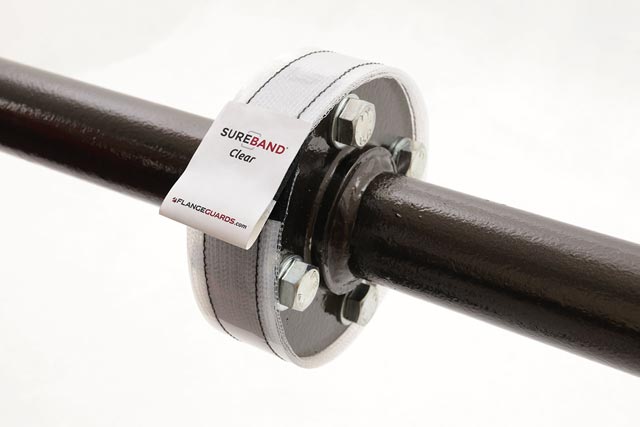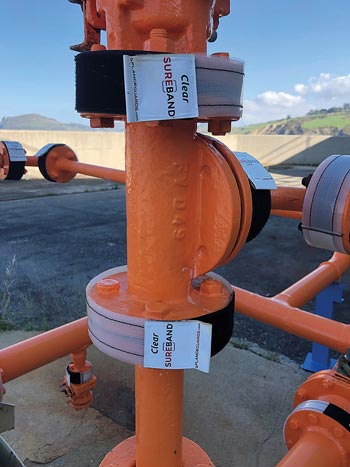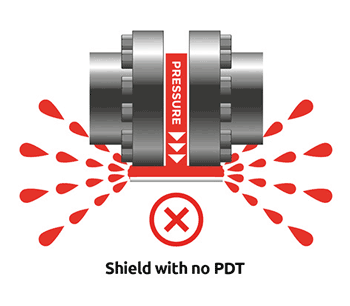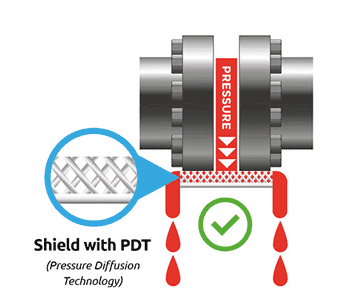
Fluid escaping from joints in pipelines can cause a hazardous spray or mist. Jeff Harwood, managing director of Flangeguards, explains the importance of safety shields.
Throughout process industries, the focus on safety of personnel and assets is growing dramatically. For a variety of reasons, from corporate policy to general best practice, safety shields are increasingly being used to control pipeline leaks.
Even at relatively low pipeline pressures, a small leak path from a flange joint will result in a spray which can travel some distance. The price of failure can be incredibly high: the cost, following a fire or explosion, can run into many millions, and uncontrolled spray-outs have sadly caused fatalities.
Modern pipe integrity and maintenance programmes, improvements in gasket technology and proper bolt torquing procedures have led to a reduction in the frequency and severity of incidents. However, pipe failures still occur, and leaks continue to happen.
Use of safety shields
Flanges are the most common application for safety shields. The flanges are used to form the connection between pipe sections, valves, pumps, strainers and other joints. This is the weak point from a leakage point of view.
Typical safety shield installations include oil lines near hot surfaces, acid lines near personnel or walkways, high pressure steam, LNG, alcohol, solvents, thermal and hydraulic oil.
Shields are commonplace in process industries including pharmaceutical, chemical, food and drink, oil and gas production, and in mining and throughout the manufacturing and utilities sectors.
Flange guards or safety shields are used not to contain a pipe-joint leak, but to control the release and stop spray and mist formation or a toxic release.
Safety shields should have some form of pressure diffusion or a means for the process fluid to coalesce inside. The means of connection should be sufficient to hold the shield in place given the pressure involved and the material should be compatible with the process.

Styles of safety shield
The most commonly used shields tend to be the “bag” style, made from a technical fabric, which wraps around the outside of the flange. The fabric is drawn down around the bolts, towards the pipe itself, with drawstrings to hold it tight in place. This makes it ideal for non-standard shapes and sizes such as valves, expansion joints, and so on. This type can be used for corrosive applications and comes either with a litmus indicator patch or a central clear section allowing flange inspection through the shield without removal.
For high temperature or pressure applications, rigid steel shields are common.
More recently, the emphasis has been on simplicity and ease of use to eliminate the potential for incorrect installation. Shields with pull cords will need knots tied (and untied) and this is fiddly work when wearing gloves, as is the use of any special tools. If the shield is difficult to fit it may not be replaced correctly, or at all, after maintenance.
Pressure diffusion
Flangeguard’s Sureband shield design uses a Quick-fit connection system which allows the shields to be fitted or removed in seconds, requiring no pull cords or special tools. It also uses innovative PDT (Pressure Diffusion Technology). Its outer band incorporates a specially formulated multi-layered internal mesh that is held against the flange. The pressure is diffused in a controlled manner, thus preventing formation of a mist or vapour cloud. At the point of exit from the shield, the leak takes the form of a safe, vertical drip or stream.
Many shield designs have no diffusion – and this can make the effects of a leak worse than having no shield at all (see below).


Pressure diffusion technology reduces the pressure on the liquid, which is emitted as a controlled drip.
Selection
Demand for shields has led to an increase in the options available, but the priority is to make sure the shield will work effectively, and will stand the test of time given the process conditions.
It is important to consider the specific pipe joints that should be shielded. For example, a flanged ball valve also has a potential leak path. This follows for any pipe joint and fitting including couplings, ball, globe, gate and butterfly valves, expansion joints and so on.
Whatever safety shield you use, make sure that some assurance has been given about its suitability for your specific process.
In the absence of an internationally recognised standard for safety shields, due diligence is key. Check the manufacturer has pressure-tested its designs and can provide evidence of spray and mist prevention, and what manufacturing quality accreditation it holds.
T: 01268 244 369 | sales@flangeguards.com
www.flangeguards.com

